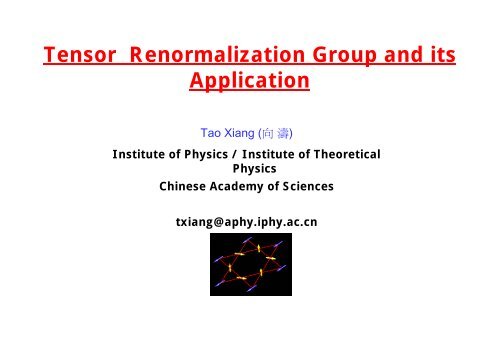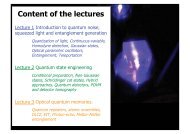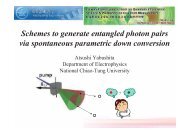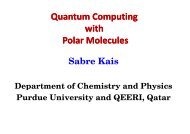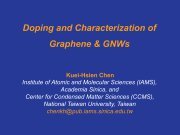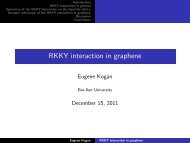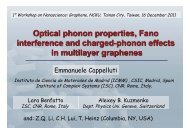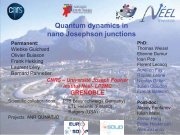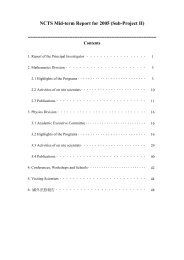Tensor Renormalization Group and its Application
Tensor Renormalization Group and its Application
Tensor Renormalization Group and its Application
You also want an ePaper? Increase the reach of your titles
YUMPU automatically turns print PDFs into web optimized ePapers that Google loves.
<strong>Tensor</strong> <strong>Renormalization</strong> <strong>Group</strong> <strong>and</strong> <strong>its</strong><strong>Application</strong>Tao Xiang ( 向 濤 )Institute of Physics / Institute of TheoreticalPhysicsChinese Academy of Sciencestxiang@aphy.iphy.ac.cn
Strong Coupling Approach2 64 → a particularly selected set of basis statesQuantum Monte CarloNumerical <strong>Renormalization</strong> <strong>Group</strong>K. Wilson• Wilson NRG 1960s–1980s‣ Kondo problem• Density-matrix renormalization group (White 1992)‣ Most accurate numerical method for studying 1Dquatnum systems‣ Poor performance in 2D
Characteristic Energy ScalesNumerical <strong>Renormalization</strong> <strong>Group</strong> Density Functional TheoryQuantum Monte Carlo Dynamical Mean FieldEnergy10 -6 10 -4 10 -2 10 0 10 2 10 4 T(K)Cold atoms 3 He-superfluid 4 He-superfluid CMR simple metalheavy fermions QHE high-Tc semiconductorsuperconductorStrong coupling Weak couplinglow Dimensionality highstrongQuantum fluctuations weakweakCoulomb screening strong
Concept of renormalization groupEnergyH 0H 1H 2••• ••• H effRG iteration• 1943 Ernst Stueckelberg initialized a renormalizationprogram to attack the problems of infinities in QEDbut his paper was rejected by Physical Review.• 1953 Ernst Stueckelberg <strong>and</strong> Andre Petermannopened the field of renormalization groupErnst Stueckelberg
Numerical <strong>Renormalization</strong> <strong>Group</strong> Method• 1974 Wilson opened the field of numericalRG by combining the idea of renormalizationgroup with numerical calculations.Kenneth Wilson• He solved the famous single-impurity Kondomodel (Kondo effect).
Basic Idea of Numerical <strong>Renormalization</strong> <strong>Group</strong>To represent a targeted stateψ0∞= ∑l=1f nllby an approximate wavefunction using alimited number of basis statesψ%0M≈ ∑ f % nl=1llsuch that their overlap is maximizedψ%ψ0 0M=∑ %l=1ffllRefine a basis set by performing a series of basis transformations
Wilson block-spin NRGH 2keep the lowest D states of H 2H = H + H + HL R LR4 2 2 4keep the lowest D states of H 4H = H + H + HL R LR2n n n 2nDiagonalize H,keep the states according to their energy
Reasons for the Failure of Wilson block-spin NRG1. Interface effect is too big2. Big truncation error:total D 2 states, but only Dof them retained3. Criterion of truncation:energy is not a goodindicator of basis statesi( +)i+1 i.H = ∑ a a + hcExample: Particle on a lattice
Density Matrix <strong>Renormalization</strong> <strong>Group</strong> (DMRG)System Environmentm 1m 2n 2m 3S. White, PRL (1992)Use Environment as apump to probe thebasis states in Systemn 3m 4|i〉 sys|j〉 envψ = ∑ f i ji,jij sys env
NRG versus DMRGWilson NRGSystemSysDMRGSystemEnvEnergy is the only quantity thatcan be used to measure theweight of a basis stateρ=e− β HUse a sub-system as a pump toprobe the other part of the systemρsys=Trenve− β HThe weight is measured by theentanglement between Sys <strong>and</strong> Env
What is a “Density Matrix” measurement?System Environment|i〉 sys|j〉 env,ψ = ∑ f i ji jij sys envQuantum Information:Schmidt decomposition∑ψ = Λnn sys envΛ n2is the eigenvalue of reduceddensity matrixnnMathematician:Singular value decompositionij in , n j,nn=1Dn=1Nf = U Λ V≈∑∑UΛVin , n j,n
DMRG Wavefunction: Matrix Product StateS Ostlund, S Rommer, PRL 1995 The wavefunction generated by the DMRG iteration is a matrix-productstate It can be also regarded as a variational ansatz of many-body wavefunction( )Ψ =∑ Tr Am [ ]... Am [ ] m...mm Lm1L1 L 1LAxx[ m ]1 2 1D×D matrixx ix i+1 bond variablesm ilocal basis
Valence bond solid stateS=11 ⎡H = ∑ S 1 ( ) 2 2iSi+ 1Si Si+1i 2 ⎢⋅ + ⋅ +⎣ 3 3⎤⎥⎦Ψ =∑m Lm1L( )Tr Am [ ]... Am [ ] m...m1 L 1L⎛ 0 0⎞ ⎛−1 0⎞⎛0 2⎞A[ − 1] = ⎜ ⎟ A[0] = ⎜ A[1]=2 0 0 1⎟ ⎜ ⎟⎝ ⎠ ⎝ ⎠ ⎝0 0 ⎠S=1/2S=1/2Affleck, Kennedy, Lieb, Tasaki, PRL 59, 799 (1988)
Haldane ConjectureInteger Heisenberg spin chain has a finite excitation gap= ∑ ⋅H SiSi + 1iHaldaneNi 2+ :S = 1Energy gapY 2BaNiO 5
Hidden OrderHidden “antiferromagnetic” order↑ 0 0 0 ↓ 0 ↑ 0 0 ↓ 0 ↑ 0 0 0 ↓ 0 ↑ 0 0 0 0 ↓Is there any order in theHaldane spin chain?↑ ↓ ↑ ↓ ↑ ↓ ↑ ↓S = -1 (↑) , 0, 1 (↓)Nd 2BaNiO 5Antiferromagneti Neel orderNeelNobel 1970YBa 2Cu 3O 6
Accuracy of the DMRG in 1DDMRG: Can calculate all static, thermodynamic, dynamic quantities1D S=1 Heisenberg modelGround state energyQuantum Monte Carlo -1.4015(5)DMRG -1.401484038971(4)(keep D = 100 states)HeisenbergNH = J∑S ri⋅S ri + 1i=1
Extend DMRG to 2D: Map 2D lattice to 1DDMRG is essentially a 1D methodMulti-chain mapping:The width of the lattice is fixedDiagonal-path:Lattice grows in both directionsT Xiang, J Z Lou, Z B Su, PRB 64, 104414 (2001)
Ground state energy of the 2D Heisenberg modelGround State Energy-0.34-0.36-0.38Square LatticeGround State Energy-0.18-0.2-0.22-0.24Triangle Lattice-0.40 0.1 0.2 0.3 0.41/LSquare TriangleDMRG -0.3346 -0.1814MC -0.334719 -0.1819SW -0.33475 -0.1822-0.260 0.1 0.2 0.31/LFree boundary conditionsΔE(L) ~1/LPeriodic boundary conditions:ΔE(L) ~ (1/L) 3
Why is the performance of DMRG poor in 2D?S 1S 2S 3S 4S 5S 61D4 5 12 133 6 11 142 7 10 151 8 9 162D1 2 3 4 5 6 72D 1D mapping• Introduce long-range coupling• Break the square lattice symmetry• Dem<strong>and</strong> grows exponentially withlattice size in order to satisfy theArea Law
Area Law of Entanglement EntropyFor a gapped systemd −1Sentanglement~ L ~lnDminenvironmentsystem( )Ψ =∑ Tr Am [ ]... Am [ ] m...mm Lm1L1 L 1‣ 1D (d=1) D min ~ L 0LAxx[ m ]1 2 1D×D matrix‣ 2D (d=2)D min ~ e LD min grows exponentially with the system size
<strong>Tensor</strong>-Network WavefunctionΨ= Tr∏λi ∈j∈blackwhitexiλyiλziAxiyiyi[ m ] Bixjyjyj[ mj]mimj keep the locality of localinteractions satisfy the area law:The number of dangling bondsis proportional to the crosssection<strong>Tensor</strong> network state = tensor product state: vertex state model Niggemann, Zittartz, 96: projected entangled-pair state (PEPS) Cirac, Verstraete, 04
Two Problems Need To Be SolvedΨ= Tr∏λi ∈j∈blackwhitexiλyiλziAxiyiyi[ m ] Bixjyjyj[ mj]mimj1. How to determine the local tensor?2. How to evaluate the expectation values, given atensor-product wavefunction?
How to determine the local tensor?[ ]Ψ = Tr∏T m mix yz i iii i1. Variational approachto minimize• Converging slowly• The bond dimension that can be treated is smallΨ H ΨΨ | ΨD ≤ 5Gu, Levin, Wen, PRB (2008)
How to determine the local tensor?Ψ= Tr∏λi ∈j∈blackwhitexiλyiλziAxiyiyi[ m ] Bixjyjyj[ mj]mimj2. Projection approach−lim e βH Ψ = ground stateβ →∞• Very accurate• Fast converging• Large bond dimension can be treated(more if symmetry is considered)Projection OperatorD ~ 70 (honeycomb lattice)D ~ 20 (square or Kagome lattice)Jiang, Weng, Xiang, PRL 101, 090603 (2008)1D: Vidal, PRL 98, 070201 (2007)
Projection Approachlimβ →∞e−βHΨ=ground statelimM →∞(−τH)Me Ψ = ground stateHeisenberg model∑H = H = H + H + HijH = JS ⋅Sij i jij x y z
Projection IterationeH−τHα=≈e−τH∑i∈blackzeH−τHi,i+αye−τHx2+ o(τ )( α = x,y,z)Trotter-Suzuki decomposition1. One iterationΨ1Ψ~Ψ20= e= e= e−τH−τH−τHxyzΨΨ0Ψ122. Repeat the above iteration until converged
Projection: x-bond∏−τH xi,je Ψ = Tr mm e mm λλλA [ m ] B [ m ] mmi i i i i i j j ji∈blackj=+i xˆ′ ′ ′ ′−τHi j i j x y z x yy i x y y j i jStep IStep IStep IIStep IIStep IIIStep IIITruncate basis spaceSVD: singular value decomposition
How accurate is this projection approachλ MFWithout performing thecanonical transformationfor the matrix productstateUsing the canonicalrepresentation of thematrix product state:λ is the eigenvalue of thedensity matrix1D Heisenberg model
Expectation ValueΨ = Tr T [ m ] mΨΨ =∏iTr∑xyy i i∏i i ixx′ , yy′ , zz′i i i i i iA = T [ m] T [ m]xx′ , yy′ , zz′ xyz x′ y′ z′mBond dimension D 2iATo evaluate〈Ψ |Ψ 〉 <strong>and</strong> 〈Ψ |O|Ψ 〉is equivalent toevaluating the partitionfunctions of classicalstatistical models,such as the S=1/2 Isingmodel
Coarse Grain <strong>Tensor</strong> <strong>Renormalization</strong> <strong>Group</strong>Z= Tr∏Tixyzii iRewiring DecimationLevin & Nave, PRL (2007)
Step I: RewiringM=∑kj,il mji mlkmN∑n=1T T= U ΛVkj, n n il,nBond field: measures theentanglement between U <strong>and</strong> V
Step II: Decimation
Accuracy of TRGD = 24Ising model on triangular lattice
Second renormalization of tensor-network state (SRG)‣ TRG:truncation error of M isminimized(envZ=Tr MM )What needs to be minimizedis the error of Z!‣ SRG:The renormalization effect ofM env to M is consideredsystemenvironmentXie et al, PRL 103, 160601 (2009)
I. Poor Man’s SRG: entanglement mean-field approach(env) ij, kl ,Z=Tr MM = ∑ M Mijklenvkl ijM = ∑ U Λ Vkj, il kj, n n il,n4n=1... DM ≈ Λ Λ Λ Λenv 1/ 2 1/ 2 1/ 2 1/2kl,ij k l i jMean field (or cavity) approximationBond field – mean field variableΛΛ = Λ 1/2 Λ 1/2From environmentFrom system
Accuracy of Poor Man’s SRGD = 24Ising model on triangular lattice
II. More accurate treatment of SRGEvaluate the environment contribution M env using TRGTRGM env
( n 1)M −ijkl1. Forward iterationM→M(0) (1)→L →M( N )( n)M i ' j ' kl ' '2. Backward iterationM→M( N) ( N−1)M(0)→L→ =MenvM M S S S S= ∑ ∑( n−1) ( n)ijkl i' j ' kl ' ' k' jp j ' pi i' lq l ' qki' j' k' l'pq
Accuracy of SRGD = 24Ising model on a triangular lattice
Error versus D
Specific Heat of the Ising model on Triangular LatticesD = 24
Quantum Heisenberg Model on Honeycomb LatticeH = J∑S r⋅ SrGround State Energy i jijSRG D = 14E = -0.54439SRG D = 30E = -0.54442Monte Carlo:E = -0.54454 ( ± 20 )Lattice size30N = 2×3U. Low, Condensed Matter Physics2009 Vol 12, 497
Heisenberg Model on Honeycomb LatticeQuantum Monte Carlo ResultE = -0.36303 (± 13) per bond= -0.54454 ( ± 20 ) per siteU. Low, Condensed MatterPhysics 2009 Vol 12, 497
Staggered MagnetizationSRG D = 15M = 0.31003Monte Carlo:M = 0.2681U. Low, Condensed MatterPhysics 2009 Vol 12, 497M = 0.22Reger, Riera, Young,JPC 1989Spin Wave:M = 0.24Series expansionM = 0.27
Staggered MagnetizationThe tensor-networkstate cuts the longrangecorrelationThe bond dimension isroughly of the order ofthe correlation length ofthe tensor-network stateThe logarithmiccorrection to the AreaLaw is important here
Staggered Magnetization4 th order polynomial fitM = 0.263Monte Carlo:M = 0.2681
Square Lattice
Kagome Lattice
Summary DMRG is an accurate numerical method for studying 1Dquantum systems In 2D, the tensor-network representation of quantum manybodystates is a good starting point The quantum tensor-network wavefunction can beaccurately <strong>and</strong> efficiently evaluated by the projectionmethod The partition function or expectation values of tensornetworkmodel/state can be accurately determined by theSRG methodAcknowledgement:Zhiyuan Xie, Qiaoni Chen, Huihai Zhao IOP / ITP, CASZhengyu Weng, Hongchen Jiang TsinghuaUniversity
<strong>Tensor</strong>-Network Representation of Classical Statistical ModelH= -J∑SiSijIsing modeljZ= Tr∏Tixyzii i<strong>Tensor</strong>-network model in dual latticeTriangular latticeDual lattice: honeycomb lattice
S 1S 2 S 3σ 1<strong>Tensor</strong>-network representationH= -J∑S Si jσ 3 σ ij2Z = Trexp− βH = Tr∏exp −βHΔ( ) ( )σσσ=SS1 2 3=SS2 3 1=SS3 1 2H ( Δ=− J σ1+ σ2 + σ3)/2σσσ = SSSSSS = 11 2 3 2 3 3 1 1 2Δ
<strong>Tensor</strong>-network representationZ= Tr T∏ixyz( )− Jβσ+ σ + σ / 2ii i1 2 3Tσσσ= e δ σ1 2 31σ2σ3−1( )S 1σ 3 σ 2S 2 S 3σ 1


